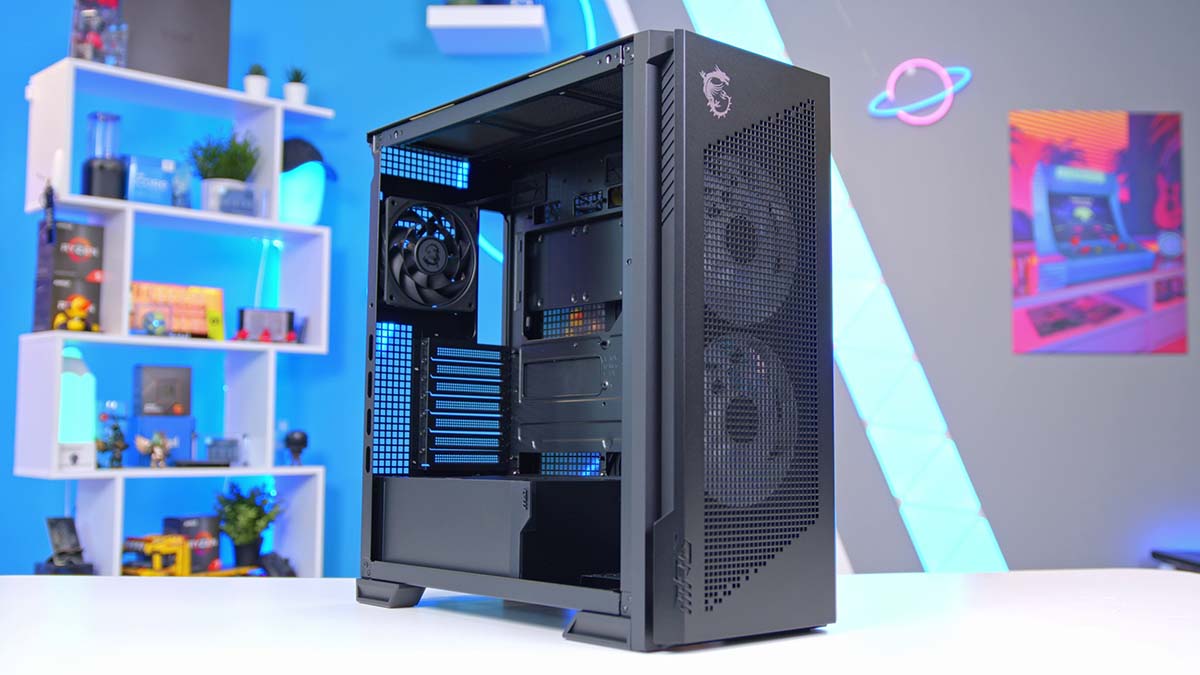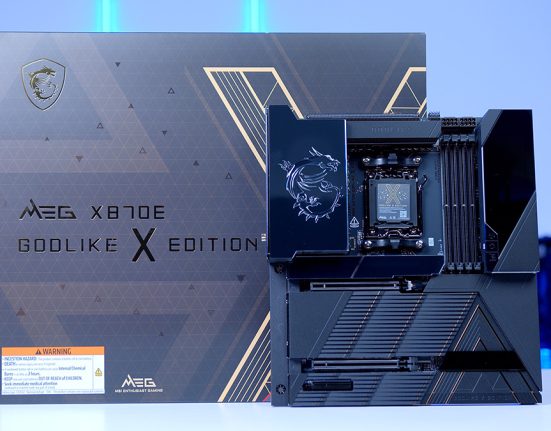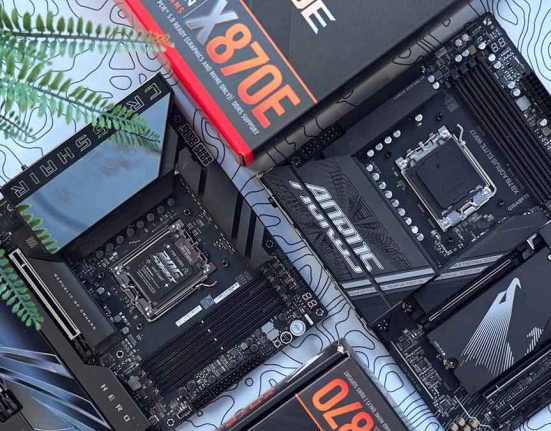The MPG Velox 300R Airflow PZ is a PC case from MSI offering modern features for the latest components and hardware, while providing ample airflow and space for cooling hardware to promote great thermals. The Velox 300R chassis is another entrant from MSI that focuses on ventilation to ensure your build remains as cool as possible while maintaining a strong and bold aesthetic for you to build on.
This isn’t the first time we’ve seen an airflow-focused case from MSI, so we’re curious to see how this model differs from older cases and market alternatives that provide similar features or come in at a comparable price point. The Antec C5 and Montech King 95 Pro are two cases that spring to mind. They offer great value propositions but also come in at similar prices to the aforementioned MPG Velox 300R Airflow. This means the Velox 300R has its work cut out if it’s going to dethrone some of the current case titans.
In this review article of the MSI MPG Velox 300R Airflow PZ, we’ve examined this chassis in plenty of detail, examining its specs, design, build quality, and features to see if it holds up against other excellent chassis on the market.
Buy the MSI MPG Velox 300R Airflow PZ on:
Specification
From a glance at the specs, the MPG Velox 300R Airflow PZ is a well-equipped case. First, this is a Mid-Tower chassis. Based on its height of 518mm, this is a larger mid-tower case, but it still fits within this category compared to a case like the HAVN HS420, which is definitely bordering on a Full-Tower design.
In terms of motherboard support, because this is a PROJECT ZERO-compatible case, there’s room for traditional motherboards and reverse-connect options. If you’re using a standard board, this case supports all of the major form factors, from Mini-ITX, all the way up to E-ATX, with space for boards up to 305mm wide. However, this case only has space for ATX motherboards on the reverse-connect side. This is a limitation, but because new boards are being released at Computex, more options will be hitting the shelves this year.

While it’s great to see the support for PROJECT ZERO, it does feel slightly redundant until new chipsets hit the shelves. The reverse connector tech was popular briefly, but it died as we moved onto B850 and X870 chipsets. However, Computex is likely to spark a revival for these boards.
In terms of IO support, the Velox 300R has three USB ports in total: one USB 3.2 Gen2 Type-C port and two USB 3.2 Gen1 Type-A ports, which is pretty standard across most modern cases. Alongside these USB ports is a 3.5mm combo jack that can be used as a microphone or headset port.
| Specification | MSI MPG Velox 300R Airflow PZ |
|---|---|
| Form Factor | Mid-Tower |
| Motherboard Support | Mini-ITX, Micro-ATX, ATX, E-ATX (Up to 305mm) Reverse-Connect: ATX |
| Case Dimensions (L x W x H) | 485mm x 235mm x 518mm |
| Front IO | 1 x USB 3.2 Gen2 Type-C 2 x USB 3.2 Gen1 Type-A 1 x 3.5mm Combo Jack |
| PCI-E Slots | 7 |
| Colour | Black White |
| Max Clearance | 165mm Cooler Height 400mm GPU Length 200mm PSU Length |
| Drive Support | Up to 4 x 2.5 inch Up to 2 x 3.5 inch |
| Fan Support | Front: 3 x 140mm Rear: 1 x 120mm Top: 3 x 140mm Side: 3 x 120mm PSU Shroud: 2 x 120mm Bottom: 1 x 120mm |
| Radiator Support | Front: Up to 360mm Rear: Up to 120mm Top: Up to 360mm Side: Up to 360mm |
| Pre-Installed Fans | 3 |
Regarding clearances, the Velox 300R supports graphics cards up to 400mm long, so there’s ample room for modern RTX-50 series and Radeon 9000 GPUs. This case also has space for CPU coolers up to 165mm tall and power supplies up to 200mm long, so there’s generally plenty of space for modern components to fit.
For cooling components, the Velox 300R is slightly different from other cases we’ve reviewed previously. MSI has maximised fan space, with the Velox 300R supporting a maximum of thirteen fans across all panels, three of which are 140mm fans on the front and top panels. For radiator clearance, the front, top, and side panels all have space for a 360mm radiator, which is a tremendous amount of room to keep everything nice and cool.

This chassis comes equipped with three pre-installed fans straight out of the box. There are two 160mm fans on the front panel and a 120mm fan at the rear. It’s interesting to see 160mm fans, as these aren’t a common form factor. The only downside is that swapping these out for other 160mm fans might be a pain, as this particular size can be challenging to source.
Lastly, there is the price. The MSI MPG Velox 300R Airflow PZ has an MSRP of $149.99. This price aligns it with chassis like the Montech King 95 Pro, Lian Li O11 Vision, and HYTE Y60. I feel the MSRP is a bit higher than the mentioned alternatives. While the Velox 300R looks to be a solid PC case on paper, its features and building quality will determine if the $150 price point is worth it.
MSI MPG Velox 300R Airflow PZ Design
Moving onto the design, the Velox 300R is a traditional ATX case with a metal mesh front panel that shows the two 160mm addressable RGB fans, while the side panel has a full tempered glass window. MSI has delved into the dual-chamber space with cases like the Maestro and PANO, so it’s nice to see a return to a more standard-looking case.

The front panel is somewhat bulky but can be easily removed by simply pulling it away from the front of the chassis. It’s secured with a tool-less mechanism. The front panel features a metal mesh, allowing air to flow freely through the front. Behind this, you’ll spot the two 160mm RGB fans. Fortunately, the front panel utilises an adjustable bracket, so if you’re not a fan of the 160mm fans, these can be swapped for 140mm or 120mm options. Each fan also uses PWM and addressable RGB connectors, so they’re incredibly easy to plug in.

Moving around to the side, MSI has provided a full tempered glass panel, offering an unhindered window into your build. It’s nice to see a full sheet of tempered glass, as it’s relatively common for manufacturers to provide a half panel, which can be a bit more restrictive regarding viewing angles.
Inside the chassis, there’s ample space for a wide range of components. It’s clear from the design alone that MSI built this case to maximise space. There’s plenty of mounting for fans and coolers, including the side panel. This also doubles as space for custom liquid loops, such as a pump/reservoir combo, which is ideal for enthusiasts.

With this case being fairly tall, builders won’t be restricted when plugging in cables and headers at the top of the motherboard. It’s fairly common for smaller mid-towers (like the FRAME 4000D or Antec C5) to almost cut off this area once the cooler is installed, making plugging in cables a nightmare. So it’s good to see there’s plenty of space here.
There are a few areas of note inside the case. First of all, there is the integrated GPU holder. While this won’t support every card, especially the smaller two-fan variants, this saves you from having to install a bracket and immediately eliminates any sag. It can easily be adjusted by loosening the screw and sliding it up or down.

On the back of the fans at the front is a small switch, which provides a way to adjust the fan speed from low to medium to high. While I can’t see this being used all the time, some builders may find it handy to quickly adjust the speed to accommodate higher temperatures without adjusting fan curves or playing around with software.
Lastly, around the motherboard tray are cutouts for reverse-connect motherboards. This is a PZ (PROJECT ZERO) supported case, so if you plan on building a PC with hidden cabling, this chassis supports it. As this isn’t a dual-chamber case, builders will have to be a bit savvy regarding cable management. There’s limited clearance between the back of the case and the rear side panel, so any bulge will make putting this panel on fairly difficult.

Because there are no rubber grommets around the case and plenty of cutouts, builders must also be selective about where cables are suspended. If you’re building a super clean PC, keeping as many wires and cables as possible out of view is likely to be a priority, but this is harder to do in the Velox 300R.
Despite all this, the Velox 300R offers plenty of room around the back of the case to affix cables. Additionally, MSI provides a fan and RGB hub with four headers on either side. This is particularly useful for those trying to minimise taking up motherboard headers.

Overall, the MSI MPG Velox 300R Airflow PZ is mainly built for function over form. This isn’t the worst-looking case on the market, but it isn’t the best either. I think the front panel design is nice, and the colouring is consistent across the whole chassis, but it’s not the most impressive when it comes to looks. There are some great features and design qualities here, but I’d argue that the Velox is more of a workhorse than a showpiece.
Building in the MSI MPG Velox 300R Airflow PZ
Internal Space
Internal space is one of the Velox 300R’s key strengths. With room for E-ATX motherboards, 360mm liquid coolers across three panels, and a huge amount of space for fans, it’s clear that the Velox 300R is designed to accommodate modern builds.
As we discussed in the design section of this article, there’s ample room for various build configurations. The Velox 300R has 400mm of clearance for long graphics cards, which is ample space for the RTX 5000 and Radeon 9000 cards that will be available in 2025.

Securing the motherboard and graphics cards was incredibly straightforward in terms of getting components installed. James decided to lay the case flat during the build, which we always recommend first-time builders do, as this will minimise the risk of dropping the board. All the standoffs are accurately labelled, so if you use a Micro-ATX or Mini-ITX motherboard, changing these around is simple.
Later on, mounting the GPU was a simple process. Fortunately, the Velox 300R uses screw-in PCI-E covers, so you can loosen the screws and put the covers aside. We used an MSI Gaming X Trio 5070 Ti, a 338mm long card, and there is plenty of clearance beyond the length of this GPU.

After this, we adjusted the GPU support bracket to alleviate sag. This can be done by loosening the screw at the back of the case, and simply sliding the bracket upwards based on your requirements.

Radiator and Fan Mounting
Cooling and fan support are another one of the strengths of this case. Immediately out of the box, you can leverage three pre-installed fans, two of which are 160mm fans, so they can push plenty of air. The Velox fans also utilise a dual-layer blade design to concentrate more airflow and optimise heat dissipation. There’s also extra space for fans at the bottom of the case, side, top, and on the PSU shroud. However, the three will suffice for those looking to avoid parting with extra cash.

In this particular build, we used a 360mm radiator on the top panel and installed the ID Cooling INF 360. Getting the radiator mounted was straightforward, and simply a case of using the radiator screws to secure it to the top panel. There’s a decent bit of clearance below the radiator and fans to pass through any cables or wires, so you won’t have to pre-emptively plug anything in, it can be done as you go.

Again, if you want more space for extra CPU liquid coolers, the side and front panels have room for up to a maximum of 360mm AIO (all-in-one), so there are plenty of ways to configure cooling.
Ease of Building
The MSI MPG Velox 300R Airflow PZ offers a solid building experience. This chassis is designed to keep things straightforward, and that’s precisely what it does. However, there is a lack of tool-less mechanisms and interesting features, such as a rotatable set of PCI-E covers or space for a screen module. But what the Velox 300R lacks in complexity, it makes up for by providing a really solid experience in the simple features it does offer.
There are ample cable routing channels and plenty of clearance between the top panel and the motherboard. It has three pre-installed fans that will easily get you started if you’re a first-time builder. Everything is painless to install, and most first-time builders will have no issues configuring a system inside this case.
Features We Like
Included Fan & RGB Hub
Fans and RGB hubs provide a great way for builders to connect fans and components and sync them without using splitters, so seeing the Velox 300R offer one is great. This minimises the number of headers on your motherboard and caters to those with plenty of devices.

Adjustable Front Bracket
Similar to Corsair’s InfiniRail mounting system, the Velox 300R employs an adjustable bracket that accommodates fans of different sizes. There’s space for 160mm fans by default, but this can easily be changed for 140mm and 120mm fans if you want to adjust the configuration.

Features We Don’t Like
Boring IO
Unfortunately, the Velox 300R has a pretty standard selection of IO ports. There are two USB 3.2 Gen1 Type-A ports and one USB 3.2 Gen2x2 port. While I understand this was likely to reduce costs, it’s still a limiting factor if you have plenty of peripherals and external devices.

Conclusion
MSI MPG Velox 300R Airflow PZ
Product Name: MPG Velox 300R Airflow PZ
Brand: MSI
-
Features
-
Design
-
Versatility
-
Value For Money
Summary
The MSI MPG Velox 300R Airflow PZ is a mid-tower case designed to be a simple, hassle-free chassis for you to build in. It doesn’t offer any particularly standout or unique qualities. Still, despite this, its minimalist nature keeps it away from proprietary features, allowing you to fit out a range of different build configurations to your heart’s content. There’s plenty of room for varying component sizes and ample space for fans and additional coolers. It has three pre-installed fans to get you started and a hub to minimise the impact on motherboard headers. If we’re looking at this purely from a building perspective, the Velox 300R does what it says on the tin, offering plenty of space for various configurations.
However, its simplicity is where it falls flat. This is a $150 case. Not $100 or even $80, it has an MSRP of $149.99. This means it is in direct competition with exceptional pieces of manufacturing like the Montech King 95 Pro and Lian Li O11 Vision, or alternatives like the Fractal Design North and FRAME 4000D RS ARGB. After working extensively with all of these cases, I can pick out several excellent features that make all of these alternatives stand out, offering a greater value proposition than the Velox 300R. If the Velox 300R were cheaper, it’d be much easier to justify, but at this price point, it’s hard to recommend over the alternatives, especially when there are similar cases to the Velox 300R that are considerably cheaper in the current market.
Pros
✅ Great to build in
✅ Included fan and RGB hub
✅ Three pre-installed fans
Cons
❌ Very simple
❌ Lacklustre IO
❌ Uncompetitive pricing








